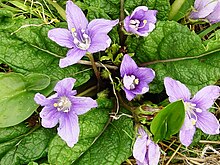
Back Alraune (Kulturgeschichte) ALS Alraun Azerbaijani Alraune (Kulturgeschichte) German Alraunijuur Estonian ماندراک - مهر گیاه Persian Alrauna Polish Альраун Russian



A mandrake is the root of a plant, historically derived either from plants of the genus Mandragora (in the Solanaceae family) found in the Mediterranean region, or from other species, such as Bryonia alba (the English mandrake, in the Cucurbitaceae family) or the American mandrake (Podophyllum peltatum in the Berberidaceae family) which have similar properties. The plants from which the root is obtained are also called "mandrakes". Mediterranean mandrakes are perennial herbaceous plants with ovate leaves arranged in a rosette, a thick upright root, often branched, and bell-shaped flowers followed by yellow or orange berries. They have been placed in different species by different authors. They are highly variable perennial herbaceous plants with long thick roots (often branched) and almost no stem. The leaves are borne in a basal rosette, and are variable in size and shape, with a maximum length of 45 cm (18 in). They are usually either elliptical in shape or wider towards the end (obovate), with varying degrees of hairiness.[1]
Because mandrakes contain deliriant hallucinogenic tropane alkaloids and the shape of their roots often resembles human figures, they have been associated with magic rituals throughout history, including present-day contemporary pagan traditions.[2]
The English name of the plant derives from Latin mandragora, related to the French main-de-gloire (hand of glory).[3] In German, it is known as alraune ('all-rune' or 'elf-rune'), referring to the plant's folkloric ability to impart wisdom.[4] Certain sources cite the Dutch name pisdifje ('brain thief'), claiming the plant grows from the brains of dead thieves, or the droppings of those hung on the gallows.[5]
- ^ Cite error: The named reference
Ungr98was invoked but never defined (see the help page). - ^ John Gerard (1597). "Herball, Generall Historie of Plants". Claude Moore Health Sciences Library. Archived from the original on 2012-09-01. Retrieved 2015-08-03.
- ^ Wedgwood, Hensleigh (1855). "On False Etymologies". Transactions of the Philological Society (6): 67.
- ^ "Alraune (Kulturgeschichte)", Wikipedia (in German), 2023-03-05, retrieved 2023-03-06
- ^ Leland, Charles Godfrey (1892). Etruscan Roman Remains in Popular Tradition. T. F. Unwin.
© MMXXIII Rich X Search. We shall prevail. All rights reserved. Rich X Search